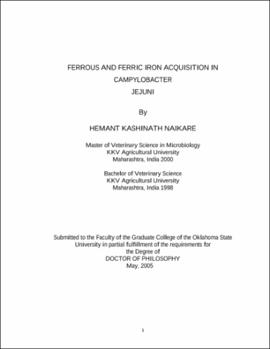| dc.contributor.advisor | Stintzi, Alain | |
| dc.contributor.author | Naikare, Hemant Kashinath | |
| dc.date.accessioned | 2013-11-26T08:35:16Z | |
| dc.date.available | 2013-11-26T08:35:16Z | |
| dc.date.issued | 2005-05 | |
| dc.identifier.uri | https://hdl.handle.net/11244/7668 | |
| dc.description.abstract | Scope and Method of study: Identification of colonization and virulence determinants that contribute to C. jejuni infection and survival in the gastrointestinal tract of the animal host would be an important tool in designing intervention strategies to combat the infection. Availability of iron in the host is a key environmental factor for controlling the establishment of many bacterial infections. The global aim of this project was to decipher the molecular mechanisms of iron acquisition in C. jejuni. We report the characterization of FeoB mediated ferrous iron and TonB mediated ferric iron acquisition in C. jejuni. We used directed mutagenesis to functionally disrupt the feoB and tonB genes. By performing a series of in vitro experiments such as 55Fe2+ uptake assays, cell culture based assays and microarrays; we have studied the role of FeoB in iron transport, iron accumulation and intracellular survival within human and porcine intestinal epithelial cells. TonB systems were characterized in vitro using growth promotion assays, ferric-enterobactin assays and cell culture. The FeoB and TonB systems were extensively assessed for their role in the in vivo colonization of the gastrointestinal tract of the chicken, rabbit ileal loop and the colostrums-deprived neonatal piglet models. | |
| dc.description.abstract | Findings and Conclusions: The feoB mutant was significantly impaired in iron uptake and was demonstrated to have decreased cellular iron accumulation. FeoB was found to play significant role in the intracellular survival of C. jejuni within human and porcine epithelial cells. The feoB mutant was significantly affected in its ability to colonize the gastrointestinal tract of chicks, rabbits and neonatal piglets thus highlighting its importance in the gut colonization. Growth promotion assays and ferric-enterobactin assays revealed that TonBs played specific and redundant roles in acquisition of iron from different sources. TonB3 was found to be specifically required for enterobactin utilization, whereas TonB2 and TonB3 were together required for the uptake of hemin and hemoglobin. All the tonB mutants were significantly affected in their ability to colonize the gastrointestinal tract of neonatal piglets. With the exception of tonb2 mutant, all the other series of single and double tonB mutants were affected in their ability to colonize the chicken ceca. Thus, combining our in vitro and in vivo characterization of the FeoB and TonB systems, it is clear that both the systems contribute significantly in iron transport and gastrointestinal colonization of the animal models. | |
| dc.format | application/pdf | |
| dc.language | en_US | |
| dc.rights | Copyright is held by the author who has granted the Oklahoma State University Library the non-exclusive right to share this material in its institutional repository. Contact Digital Library Services at lib-dls@okstate.edu or 405-744-9161 for the permission policy on the use, reproduction or distribution of this material. | |
| dc.title | Ferrous and ferric iron acquisition in Campylobacter jejuni | |
| dc.contributor.committeeMember | Confer, Anthony | |
| dc.contributor.committeeMember | Morton, Rebecca | |
| dc.contributor.committeeMember | Burnap, Robert | |
| dc.contributor.committeeMember | Emslie, A. Gordon | |
| osu.filename | Naikare_okstate_0664D_10556.pdf | |
| osu.accesstype | Open Access | |
| dc.type.genre | Dissertation | |
| dc.type.material | Text | |
| thesis.degree.discipline | Veterinary Pathobiology | |
| thesis.degree.grantor | Oklahoma State University | |
